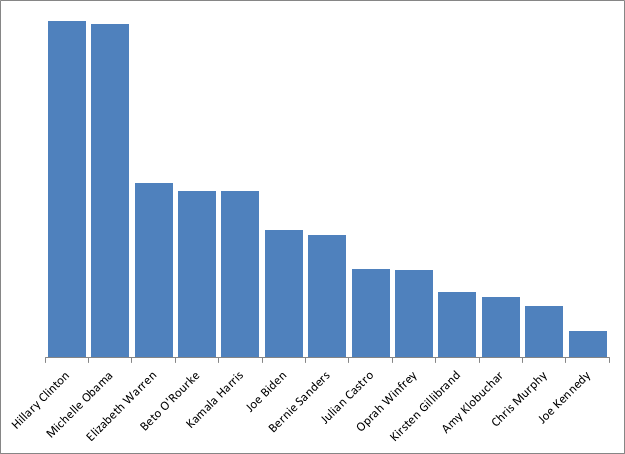** Note this is an excerpt from a previously published January 2019 report, prior to announcement by Kamala Harris of her intent to run
———————-
Though still early in the process, we wanted to see what SMI says about the potential 2020 candidates. Recall that SMI was the earliest quantitative-based forecast to call victories for Trump, Macron, and Bolsonaro. None of these candidates were early favorites based on traditional analysis, but they stood out like soar thumbs when using SMI. In short, one of SMI’s greatest features is its ability to identify early trends, such as standout candidates, before they become apparent using other methods.
We’ve analyzed 30+ potential 2020 Democratic candidates, looking for those standout candidates who make waves early. Unfortunately for Democrats, the current scenario does not look that attractive according to SMI.
Chart 1: Social Media Influence (SMI) of top potential Democratic Candidates for 2020
Source: ZettaCap
There are a number of surprises here. Most would not likely expect Hillary Clinton to be leading. Even without actively campaigning or seeking national attention, her SMI retains the Democratic leadership of potential candidates. She even beats, albeit narrowly, Michelle Obama, who has been promoting her memoir and giving media interviews of late.
Another potential surprise is the strength of Beto O’Rourke due to his relatively recent entrance onto the national stage. But if he was to be a repeat of Barak Obama as some speculate, these figures look rather low. In other words, he looks like a strong early contender for a new entrant but not one who will waltz through the primaries or be favored going into a general election.
The weakness of Biden’s SMI is surprising as well. Many traditional political analysts see Biden as a strong candidate. Additionally in early state-level and national polls, he is at the top or in second place in almost every one. In other words, polls have him as the early front-runner. Betting markets have him currently in 3rd place, but within just 3 percentage points of the leader. His weak SMI forecasts a coming slide in his electoral fortunes. Without a major change, early enthusiasm around this potential candidate will likely flame out.
Bernie Sanders has faded considerably since his 2016 showing, when his SMI matched that of Clinton near the start of the primary season. His SMI decline is negative considering Clinton’s SMI has remained rather firm with relatively little effort.
After Sanders, SMI of the remaining candidates drops dramatically. Without boosting their SMI, candidates with SMIs lower than Sanders should not be considered attractive presidential candidates.
Other potential Democratic candidates who did not produce sufficient SMI to make the chart include: Tim Kaine, Jerry Brown, Mike Bloomberg, Tom Steyer, Pete Buttigieg, John Hickenlooper, Jay Inslee, Terry McAuliffe, Eric Garcetti, Sherrod Brown, Al Gore, Martin O’Malley, Lincoln Chafee, and Jim Webb. Some of these potential candidates receive considerable media attention and/or are well known nationally, however, their SMIs are actually surprisingly low.
